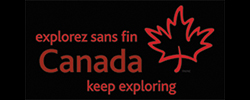Flora, Fauna, Geology & Weather
Flora and Fauna
In the Arctic regions of Yukon and Northwest Territories, weather patterns that include cold temperatures, a short growing season and glaciation only 10,000 years ago result in less diversity. Plants and trees have adapted to an extreme climate and a thin layer of useful soil. Although, Black and White Spruce are the most common tree species, others include Jack Pine, Tamarack, Paper Birch, Trembling Aspen, and Balsam Poplar. Willows and alders are the most common shrubs. Lichens, which provide food for caribou, join mosses and heaths such as Labrador Tea and berry-laden plants such as cranberries and blueberries to provide a dense ground cover throughout the region. Flowers abound throughout the season with the most prolific displays in the spring and early summer with clusters of Arctic lupine, moss campion, mountain avens, fireweed, river beauty, sweat pea and twin flowers. The high level of conifer forest makes the regions vulnerable to fire. The fires cause a release of nutrients that release and germinate the seeds of the Black Spruce and Jack Pine.
The small level of diversity found in the ecosystems provide habitat for a surprisingly diverse number of birds and mammals. Mammals range from the large land animals including the barrenland and woodland caribou, brown and black bears, moose, arctic wolf and muskox to the smaller varieties of red fox, wolverine, lynx, ermine, arctic hare and arctic ground squirrel or sicsic. Birds are abundant although the birds such as thrushes, kingfishers, robins and other songbirds, and the ground birds like grouse and ptarmigan are sometimes hard to spot. The large birds of prey such as the golden and bald eagles, osprey, goshawk, peregrine and gyrfalcons are seen most often of any birds. Jaegers, ravens, arctic terns, gulls do spend time over the rivers. Shore birds including plovers and sandpipers, and loons, eiders and mergansers are evident in most regions. The larger birds such as Sandhill Crane, Snow Geese, and Trumpeter and Tundra Swan appear for us at opportune times but are more rare.
Fish stocks include salmon, Arctic char, bull trout, dolly varden, lake trout, pike, inconnu, whitefish and Arctic grayling.
Geology
The Arctic Geology is dominated by the Northern Cordillerian Region that includes the mountains and uplands of the Rocky Mountains and the valleys and basins of the Mackenzie and Yukon Rivers and their tributaries. This is called the Innuitain Orogen. An Orogen is a section of the earth’s crust measuring some thousands of kilometres across that has been impacted by geological deformation that in the case of the Arctic has been mountain building. The far north of the Yukon and Northwest Territories has its own geology that includes the sedimentary rock of the Arctic Coastal Plains and Continental Sub-Arctic of the Northern Interior Plains.
The north contains some of the oldest rock known to man. The Bedrock geology of the Arctic is extremely varied and exposed due to of the thin soil layer that has formed because of low levels of vegetative material, extensive glaciation and the slow rate of weathering since the land is frozen for large periods of time. Hiking or paddling through this region makes one think that this land has gone through huge upheaval. In prehistoric times, the Yukon and Northwest Territories were part of a tropical plain where rivers snaked across the landscape. The rivers we paddle are called antecedent rivers that means they were there before the mountains rose up. The landscape is full of cliffs and mountain sides where forces have pushed the patterns of rock up on their sides and produce unusual vertical and wavy patterns of rock.
Large portions of the land are also frozen during the year. Permafrost is defined as having been frozen for at least two years. There are two types of permafrost: discontinuous and continuous. Discontinuous permafrost is in areas where the climate drops to slightly below freezing often in sheltered locations. In contrast where the climate is below -5°C then continuous permafrost forms. Permafrost can be from a few inches to over 1,000 feet deep.
Weather
In our experience, the weather in the north is not unlike weather in Ontario. Normally daytime temperatures can range from 20° C (70° F) to 30° C (90° F). The weather is usually dry and sunny, with daylight lasting 22 to 24 hours. Nighttime temperatures relate to how warm it has been during the day where expectation can be that if it is 20° C (70° F) during that day, it could be fairly cool at night. Typically, the days are warm and sunny and the nights are pleasant. The general climate is dry, with warm, sunny days, in which temperatures can reach 35°C (95F).
“Weather is what you get; climate is what you expect” is an old saying that shows how unpredictable the weather can really be. Over the course of more than twenty years, Canoe North Adventures has had less than a handful of trips where the weather has been either rainy or cold. For this reason, we recommend you prepare for uncertain weather since cold spells and high winds can occur.
Global warming has meant that particular temperature is warmer, much warmer. Most of Canada has seen warming, but the greatest warming has been in the northwest part of the country up to perhaps as much as two degrees Celsius on average over the last 50 years.


